Discovering Potential Anti-Oral Squamous Cell Carcinoma Mechanisms from Kochiae Fructus Using Network-Based Pharmacology Analysis and Experimental Validation
Abstract
:1. Introduction
2. Materials and Methods
2.1. KF Compounds
2.2. Target Gene Identification
2.3. Functional Enrichment Analysis, Protein–Protein Interaction (PPI) Network Construction, and Screening of Hub KFTs
2.4. Molecular Docking Analysis Using AutoDock Vina
2.5. Preparation of KFE
2.6. Cell Culture
2.7. Cell Viability Assay
2.8. Quantifying Apoptosis Using the Annexin V Dead Cell Kit
2.9. Western Blot Analysis
2.10. Statistical Analysis
3. Results
3.1. Identification of KF Compounds and Their Targets
3.2. Functions of KFTs Enriched in Biological Pathways
3.3. Relationships of KFTs with Autophagy, Apoptosis, and OSCC
3.4. Analysis of the KF Compound OA: Function in Biological Processes and Pathways
3.5. Molecular Docking Analyses
3.6. Effects of KFE, OA, and CP on the Viability of SCC-15 Cells: Results of MTT and CCK-8 Assays
3.7. Mechanism Underlying SCC-15 Cell Death Induced by KFE Treatment
3.8. KFE and OA Induced Autophagic Cell Death in SCC-15 and SCC-25 Cells
4. Discussion
5. Conclusions
Supplementary Materials
Author Contributions
Funding
Institutional Review Board Statement
Informed Consent Statement
Data Availability Statement
Conflicts of Interest
References
- Sung, H.; Ferlay, J.; Siegel, R.L.; Laversanne, M.; Soerjomataram, I.; Jemal, A.; Bray, F. Global Cancer Statistics 2020: GLOBOCAN Estimates of Incidence and Mortality Worldwide for 36 Cancers in 185 Countries. CA Cancer J. Clin. 2021, 71, 209–249. [Google Scholar] [CrossRef] [PubMed]
- Eastman, A. Activation of programmed cell death by anticancer agents: Cisplatin as a model system. Cancer Cells 1990, 2, 275–280. [Google Scholar] [PubMed]
- Lee, B.J.; Chon, K.M.; Kim, Y.S.; An, W.G.; Roh, H.J.; Goh, E.K.; Wang, S.G. Effects of cisplatin, 5-fluorouracil, and radiation on cell cycle regulation and apoptosis in the hypopharyngeal carcinoma cell line. Chemotherapy 2005, 51, 103–110. [Google Scholar] [CrossRef] [PubMed]
- Kiyota, N.; Tahara, M.; Mizusawa, J.; Kodaira, T.; Fujii, H.; Yamazaki, T.; Mitani, H.; Iwae, S.; Fujimoto, Y.; Onozawa, Y.; et al. Weekly Cisplatin Plus Radiation for Postoperative Head and Neck Cancer (JCOG1008): A Multicenter, Noninferiority, Phase II/III Randomized Controlled Trial. J. Clin. Oncol. 2022, 40, 1980–1990. [Google Scholar] [CrossRef] [PubMed]
- Mondal, S.; Bandyopadhyay, S.; Ghosh, M.K.; Mukhopadhyay, S.; Roy, S.; Mandal, C. Natural products: Promising resources for cancer drug discovery. Anticancer Agents Med. Chem. 2012, 12, 49–75. [Google Scholar] [CrossRef]
- Zhao, J.; Yang, J.; Tian, S.; Zhang, W. A survey of web resources and tools for the study of TCM network pharmacology. Quant. Biol. 2019, 7, 17–29. [Google Scholar] [CrossRef]
- Demain, A.L.; Vaishnav, P. Natural products for cancer chemotherapy. Microb. Biotechnol. 2011, 4, 687–699. [Google Scholar] [CrossRef]
- Li, Y.; Li, S.; Meng, X.; Gan, R.Y.; Zhang, J.J.; Li, H.B. Dietary Natural Products for Prevention and Treatment of Breast Cancer. Nutrients 2017, 9, 728. [Google Scholar] [CrossRef]
- Matsuda, H.; Dai, Y.; Ido, Y.; Yoshikawa, M.; Kubo, M. Studies on kochiae fructus. IV. Anti-allergic effects of 70% ethanol extract and its component, momordin Ic from dried fruits of Kochia scoparia L. Biol. Pharm. Bull. 1997, 20, 1165–1170. [Google Scholar] [CrossRef]
- Zou, W.; Tang, Z.; Long, Y.; Xiao, Z.; Ouyang, B.; Liu, M. Kochiae Fructus, the Fruit of Common Potherb Kochia scoparia (L.) Schrad: A Review on Phytochemistry, Pharmacology, Toxicology, Quality Control, and Pharmacokinetics. Evid.-Based Complement. Alternat. Med. 2021, 2021, 5382684. [Google Scholar] [CrossRef]
- Xiao, Z.; Xiao, S.; Zhang, Y.; Pan, T.; Ouyang, B. The Anti-Inflammatory Effect of Fructus Kochiae on Allergic Contact Dermatitis Rats via pERK1/2/TLR4/NF-kappaB Pathway Activation. Evid.-Based Complement. Alternat. Med. 2018, 2018, 1096920. [Google Scholar] [CrossRef]
- Cho, H.D.; Kim, J.H.; Park, J.K.; Hong, S.M.; Kim, D.H.; Seo, K.I. Kochia scoparia seed extract suppresses VEGF-induced angiogenesis via modulating VEGF receptor 2 and PI3K/AKT/mTOR pathways. Pharm. Biol. 2019, 57, 684–693. [Google Scholar] [CrossRef] [PubMed]
- Houlihan, A.J.; Conlin, P.; Chee-Sanford, J.C. Water-soluble exudates from seeds of Kochia scoparia exhibit antifungal activity against Colletotrichum graminicola. PLoS ONE 2019, 14, e0218104. [Google Scholar] [CrossRef] [PubMed]
- Kubo, M.; Matsuda, H.; Dai, Y.; Ido, Y.; Yoshikawa, M. Studies on Kochiae Fructus. I. Antipruritogenic effect of 70% ethanol extract from kochiae fructus and its active component. Yakugaku Zasshi 1997, 117, 193–201. [Google Scholar] [CrossRef]
- Wang, J.; Yuan, L.; Xiao, H.; Xiao, C.; Wang, Y.; Liu, X. Momordin Ic induces HepG2 cell apoptosis through MAPK and PI3K/Akt-mediated mitochondrial pathways. Apoptosis 2013, 18, 751–765. [Google Scholar] [CrossRef] [PubMed]
- Liu, K.; Zhao, F.; Yan, J.; Xia, Z.; Jiang, D.; Ma, P. Hispidulin: A promising flavonoid with diverse anti-cancer properties. Life Sci. 2020, 259, 118395. [Google Scholar] [CrossRef]
- Zhang, R.; Zhu, X.; Bai, H.; Ning, K. Network Pharmacology Databases for Traditional Chinese Medicine: Review and Assessment. Front. Pharmacol. 2019, 10, 123. [Google Scholar] [CrossRef]
- Zhou, Y.; Zhou, B.; Pache, L.; Chang, M.; Khodabakhshi, A.H.; Tanaseichuk, O.; Benner, C.; Chanda, S.K. Metascape provides a biologist-oriented resource for the analysis of systems-level datasets. Nat. Commun. 2019, 10, 1523. [Google Scholar] [CrossRef]
- Wu, Y.; Zhang, F.; Yang, K.; Fang, S.; Bu, D.; Li, H.; Sun, L.; Hu, H.; Gao, K.; Wang, W.; et al. SymMap: An integrative database of traditional Chinese medicine enhanced by symptom mapping. Nucleic Acids Res. 2019, 47, D1110–D1117. [Google Scholar] [CrossRef]
- Ru, J.; Li, P.; Wang, J.; Zhou, W.; Li, B.; Huang, C.; Li, P.; Guo, Z.; Tao, W.; Yang, Y.; et al. TCMSP: A database of systems pharmacology for drug discovery from herbal medicines. J. Cheminform. 2014, 6, 13. [Google Scholar] [CrossRef]
- Yan, D.; Zheng, G.; Wang, C.; Chen, Z.; Mao, T.; Gao, J.; Yan, Y.; Chen, X.; Ji, X.; Yu, J.; et al. HIT 2.0: An enhanced platform for Herbal Ingredients’Targets. Nucleic Acids Res. 2022, 50, D1238–D1243. [Google Scholar] [CrossRef] [PubMed]
- Fang, S.; Dong, L.; Liu, L.; Guo, J.; Zhao, L.; Zhang, J.; Bu, D.; Liu, X.; Huo, P.; Cao, W.; et al. HERB: A high-throughput experiment- and reference-guided database of traditional Chinese medicine. Nucleic Acids Res. 2021, 49, D1197–D1206. [Google Scholar] [CrossRef]
- Xu, X.; Zhang, W.; Huang, C.; Li, Y.; Yu, H.; Wang, Y.; Duan, J.; Ling, Y. A novel chemometric method for the prediction of human oral bioavailability. Int. J. Mol. Sci. 2012, 13, 6964–6982. [Google Scholar] [CrossRef]
- Shen, M.; Tian, S.; Li, Y.; Li, Q.; Xu, X.; Wang, J.; Hou, T. Drug-likeness analysis of traditional Chinese medicines: 1. property distributions of drug-like compounds, non-drug-like compounds and natural compounds from traditional Chinese medicines. J. Cheminform. 2012, 4, 31. [Google Scholar] [CrossRef]
- Hubatsch, I.; Ragnarsson, E.G.; Artursson, P. Determination of drug permeability and prediction of drug absorption in Caco-2 monolayers. Nat. Protoc. 2007, 2, 2111–2119. [Google Scholar] [CrossRef]
- Attique, S.A.; Hassan, M.; Usman, M.; Atif, R.M.; Mahboob, S.; Al-Ghanim, K.A.; Bilal, M.; Nawaz, M.Z. A Molecular Docking Approach to Evaluate the Pharmacological Properties of Natural and Synthetic Treatment Candidates for Use against Hypertension. Int. J. Environ. Res. Public. Health 2019, 16, 923. [Google Scholar] [CrossRef] [PubMed]
- Daina, A.; Michielin, O.; Zoete, V. SwissADME: A free web tool to evaluate pharmacokinetics, drug-likeness and medicinal chemistry friendliness of small molecules. Sci. Rep. 2017, 7, 42717. [Google Scholar] [CrossRef] [PubMed]
- Wang, Z.; Liang, L.; Yin, Z.; Lin, J. Improving chemical similarity ensemble approach in target prediction. J. Cheminform. 2016, 8, 20. [Google Scholar] [CrossRef]
- UniProt Consortium. UniProt: A worldwide hub of protein knowledge. Nucleic Acids Res. 2019, 47, D506–D515. [Google Scholar] [CrossRef]
- Eberhardt, J.; Santos-Martins, D.; Tillack, A.F.; Forli, S. AutoDock Vina 1.2.0: New Docking Methods, Expanded Force Field, and Python Bindings. J. Chem. Inf. Model. 2021, 61, 3891–3898. [Google Scholar] [CrossRef]
- Trott, O.; Olson, A.J. AutoDock Vina: Improving the speed and accuracy of docking with a new scoring function, efficient optimization, and multithreading. J. Comput. Chem. 2010, 31, 455–461. [Google Scholar] [CrossRef]
- Laskowski, R.A.; Swindells, M.B. LigPlot+: Multiple ligand-protein interaction diagrams for drug discovery. J. Chem. Inf. Model. 2011, 51, 2778–2786. [Google Scholar] [CrossRef] [PubMed]
- Milburn, C.C.; Deak, M.; Kelly, S.M.; Price, N.C.; Alessi, D.R.; Van Aalten, D.M. Binding of phosphatidylinositol 3,4,5-trisphosphate to the pleckstrin homology domain of protein kinase B induces a conformational change. Biochem. J. 2003, 375, 531–538. [Google Scholar] [CrossRef] [PubMed]
- Thomas, M.E., 3rd; Grinshpon, R.; Swartz, P.; Clark, A.C. Modifications to a common phosphorylation network provide individualized control in caspases. J. Biol. Chem. 2018, 293, 5447–5461. [Google Scholar] [CrossRef] [PubMed]
- Sugawara, K.; Suzuki, N.N.; Fujioka, Y.; Mizushima, N.; Ohsumi, Y.; Inagaki, F. The crystal structure of microtubule-associated protein light chain 3, a mammalian homologue of Saccharomyces cerevisiae Atg8. Genes Cells 2004, 9, 611–618. [Google Scholar] [CrossRef] [PubMed]
- Lim, D.; Lee, H.S.; Ku, B.; Shin, H.C.; Kim, S.J. Oligomer Model of PB1 Domain of p62/SQSTM1 Based on Crystal Structure of Homo-Dimer and Calculation of Helical Characteristics. Mol. Cells 2019, 42, 729–738. [Google Scholar] [CrossRef]
- Pan, H.L.M.; Yang, Y.; Callaway, K.; Baker, J.; Diep, L.; Yan, J.; Tanaka, K.; Zhu, Y.L.; Konradi, A.W.; Jobling, M.; et al. Crystal Structures of apo Keap1, Keap1-peptide, and Keap1-compound complexes. Acta Crystallogr. D Biol. Crystallogr. 2013. [Google Scholar] [CrossRef]
- Lee, J.O.; Yang, H.; Georgescu, M.M.; Di Cristofano, A.; Maehama, T.; Shi, Y.; Dixon, J.E.; Pandolfi, P.; Pavletich, N.P. Crystal structure of the PTEN tumor suppressor: Implications for its phosphoinositide phosphatase activity and membrane association. Cell 1999, 99, 323–334. [Google Scholar] [CrossRef]
- Johnson, D.E.; Burtness, B.; Leemans, C.R.; Lui, V.W.Y.; Bauman, J.E.; Grandis, J.R. Head and neck squamous cell carcinoma. Nat. Rev. Dis. Primers 2020, 6, 92. [Google Scholar] [CrossRef]
- Bai, D.; Wu, Y.; Deol, P.; Nobumori, Y.; Zhou, Q.; Sladek, F.M.; Liu, X. Palmitic acid negatively regulates tumor suppressor PTEN through T366 phosphorylation and protein degradation. Cancer Lett. 2021, 496, 127–133. [Google Scholar] [CrossRef]
- Ji, J.; Zhang, L.; Wang, P.; Mu, Y.M.; Zhu, X.Y.; Wu, Y.Y.; Yu, H.; Zhang, B.; Chen, S.M.; Sun, X.Z. Saturated free fatty acid, palmitic acid, induces apoptosis in fetal hepatocytes in culture. Exp. Toxicol. Pathol. 2005, 56, 369–376. [Google Scholar] [CrossRef]
- Chen, Y.; Liu, J.; Yang, X.; Zhao, X.; Xu, H. Oleanolic acid nanosuspensions: Preparation, in-vitro characterization and enhanced hepatoprotective effect. J. Pharm. Pharmacol. 2005, 57, 259–264. [Google Scholar] [CrossRef] [PubMed]
- Pollier, J.; Goossens, A. Oleanolic acid. Phytochemistry 2012, 77, 10–15. [Google Scholar] [CrossRef] [PubMed]
- Kim, G.J.; Jo, H.J.; Lee, K.J.; Choi, J.W.; An, J.H. Oleanolic acid induces p53-dependent apoptosis via the ERK/JNK/AKT pathway in cancer cell lines in prostatic cancer xenografts in mice. Oncotarget 2018, 9, 26370–26386. [Google Scholar] [CrossRef] [PubMed]

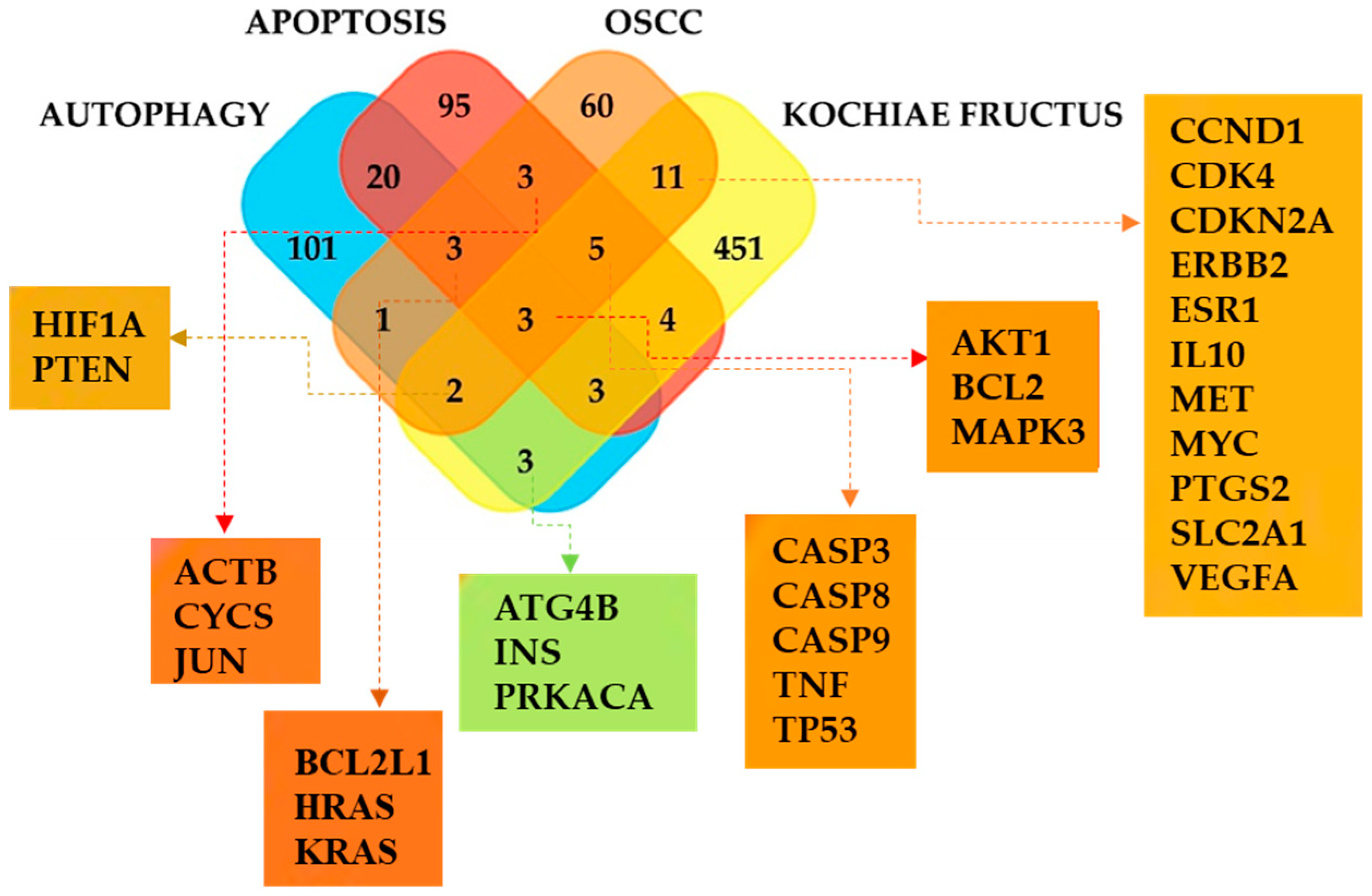
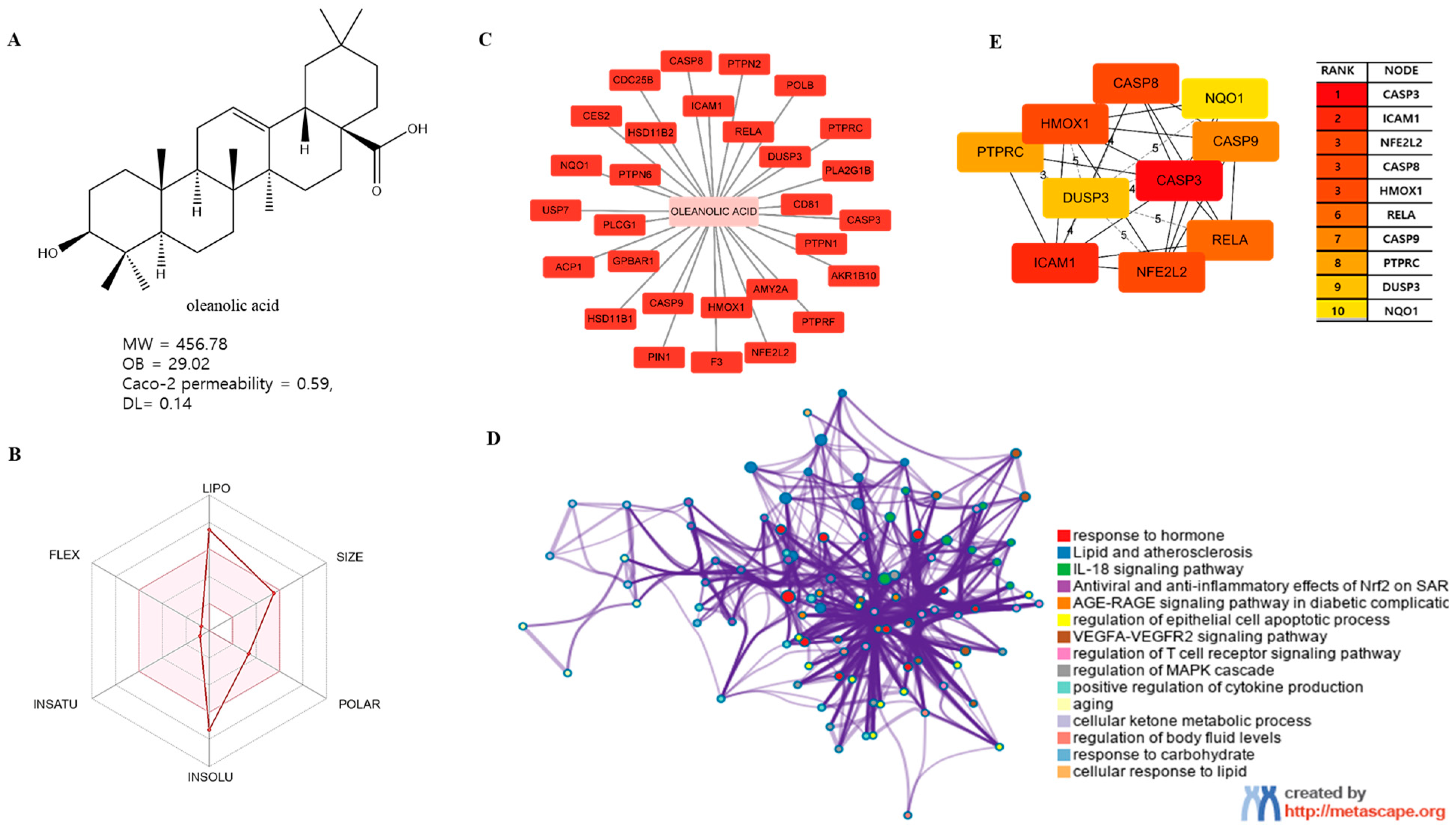



| Compounds | Formula | Physicochemical Parameters | Pharmacokinetic Parameters | ||||||||||||
|---|---|---|---|---|---|---|---|---|---|---|---|---|---|---|---|
| MW | FASA | Hd | Ha | OB | Caco | BBB | Log | HL | GI | BA | DL | Lipinski | SA | ||
| (Z)-1,3-diphenylprop-2-en-1-one | C15H12O | 208.3 | 0.53 | 0 | 1 | 47.27 | 1.48 | 1.18 | 3.7 | 20 | High | 0.6 | 0.08 | Yes | 2.41 |
| 11,14-Eicosadienoic Acid | C20H36O2 | 308.6 | 0.23 | 1 | 2 | 39.99 | 1.22 | 0.76 | 7.3 | 5.6 | High | 0.9 | 0.2 | Yes | 3.33 |
| 3-Acetylaconitine | C36H49NO12 | 687.9 | 0.2 | 2 | 13 | 37.05 | −0.22 | −0.73 | −0.6 | 26 | Low | 0.2 | No | 7.64 | |
| ∗ 5,7,4′-Trihydroxy-6,3′-Dimethoxyisoflavone | C17H14O7 | 330.3 | 0.22 | 3 | 7 | 63.36 | 0.54 | −0.12 | 2.03 | 17 | High | 0.6 | 0.34 | Yes | 3.26 |
| 9, 12-Octadecadienoic Acid | C39H70O6 | 635 | 6 | 0 | 6 | N/A | N/A | N | N | N | High | N | N | N | N |
| 9E,12Z-Octadecadienoic Acid | C18H32O2 | 280.5 | 0.25 | 1 | 2 | 41.9 | 1.16 | 0.77 | 6.39 | 5.4 | High | 0.9 | 0.14 | Yes | N |
| Aconitine | C34H47NO11 | 645.8 | 0.22 | 3 | 12 | 7.87 | −0.58 | −1.13 | −1 | N | Low | 0.2 | 0.23 | No | 7.43 |
| Arachidic acid | C20H40O2 | 312.6 | 0.18 | 1 | 2 | 16.66 | 1.18 | 1.09 | 8.19 | N | Low | 0.9 | 0.19 | Yes | 2.77 |
| Benzoylaconine | C32H45NO10 | 603.8 | 0.21 | 4 | 11 | 12.83 | −0.48 | −1.12 | −1.4 | N | Low | 0.2 | 0.25 | No | 7.16 |
| Benzoylhypaconine | C31H43NO9 | 573.8 | 0.24 | 3 | 10 | 8.7 | −0.29 | −0.74 | −0.5 | N | High | 0.6 | 0.29 | Yes | 6.95 |
| Benzoylmesaconine | C31H43NO10 | 589.8 | 0.21 | 4 | 11 | 8.55 | −0.52 | −1.11 | −1.7 | N | Low | 0.2 | 0.27 | No | 7.04 |
| Daturic Acid | C17H34O2 | 270.5 | 0.21 | 1 | 2 | 18.51 | 1.12 | 0.95 | 6.82 | N | High | 0.9 | 0.12 | Yes | 2.42 |
| Daucosterol | C35H60O6 | 577 | 0.23 | 4 | 6 | 20.63 | −0.26 | 0.97 | 6.34 | N | Low | 0.6 | 0.63 | Yes | 8.02 |
| Deoxyaconitine | C34H47NO10 | 629.8 | 0.2 | 2 | 11 | 30.96 | −0.22 | 0.74 | 0.25 | 22 | High | 0.2 | 0.24 | No | 7.35 |
| Diosgenin | C27H42O3 | 414.6 | 0.2 | 1 | 3 | 15.84 | 0.8 | 0.21 | 4.63 | N | High | 0.6 | 0.81 | Yes | 6.94 |
| Docosanoate | C22H43O2- | 340.7 | 0 | 1 | 2 | 15.69 | 1.21 | 0.91 | 9.11 | N | High | 0.9 | 0.26 | Yes | 2.96 |
| Ecdysterone | C27H44O7 | 480.7 | 0.26 | 6 | 7 | 6.94 | −1.38 | 1.93 | 1 | N | High | 0.6 | 0.82 | Yes | 6.36 |
| Flavone | C15H10O2 | 222.2 | 0.46 | 0 | 2 | 25.88 | 1.34 | 1.08 | 3.14 | N | High | 0.6 | 0.13 | Yes | 2.88 |
| ∗ Higenamine | C16H17NO3 | 271.3 | 0.34 | 4 | 4 | 82.54 | 0.63 | 0.03 | 2.57 | 3.9 | High | 0.6 | 0.21 | Yes | N |
| ∗ Hispidulin | C16H12O6 | 300.3 | 0.28 | 3 | 6 | 30.97 | 0.48 | 0.49 | 2.32 | 16 | High | 0.6 | 0.27 | Yes | 3.12 |
| Histamine | C5H9N3 | 111.2 | 0.09 | 3 | 2 | 44.1 | 0.5 | 0.37 | −0.9 | 11 | High | 0.6 | 0.01 | Yes | 1.62 |
| Hypaconitine | C33H45NO10 | 615.8 | 0.2 | 2 | 11 | 7.16 | −0.1 | 0.41 | −0.1 | N | High | 0.2 | 0.26 | No | 7.22 |
| ∗ Isorhamnetin | C16H12O7 | 316.3 | 0.32 | 4 | 7 | 49.6 | 0.31 | 0.54 | 1.76 | 14 | High | 0.6 | 0.31 | Yes | 3.26 |
| Lignoceric Acid | C24H48O2 | 368.7 | 0.17 | 1 | 2 | 14.9 | 1.24 | 1.01 | 10 | N | Low | 0.9 | 0.33 | Yes | 3.24 |
| Linoleic acid | C18H32O2 | 280.5 | 0.25 | 1 | 2 | 41.9 | 1.16 | 0.9 | 6.39 | 7.5 | High | N/A | 0.14 | Yes | N |
| Linolenic Acid | C18H30O2 | 278.5 | 0.26 | 1 | 2 | 45.01 | 1.22 | 0.95 | 5.95 | 6.1 | High | N/A | 0.15 | N | N |
| Mesaconitine | C33H45NO11 | 631.8 | 0.2 | 3 | 12 | 8.7 | −0.35 | 0.95 | −1.3 | N | Low | 0.2 | 0.24 | No | 7.31 |
| Momordin Ic | C41H64O13 | 765.1 | 0.25 | 7 | 13 | 10.77 | −1.69 | 2.23 | 3.65 | N | Low | 0.1 | 0.15 | No | 8.65 |
| Myristic Acid | C14H28O2 | 228.4 | 0.19 | 1 | 2 | 21.18 | 1.07 | 0.99 | 5.46 | N | High | 0.9 | 0.07 | Yes | 2.09 |
| Oleanolic Acid | C30H48O3 | 456.8 | 0.25 | 2 | 3 | 29.02 | 0.59 | 0.07 | 6.42 | 3.3 | Low | 0.9 | 0.76 | Yes | 6.08 |
| Oleic Acid | C18H34O2 | 282.5 | 0.2 | 1 | 2 | 33.13 | 1.17 | 0.78 | 6.84 | 5 | High | 0.9 | 0.14 | Yes | 3.07 |
| Palmitic Acid | C16H32O2 | 256.5 | 0 | 1 | 2 | 19.3 | 1.09 | 1 | 6.37 | N | High | 0.9 | 0.1 | Yes | 2.31 |
| Phytol | C20H40O | 296.6 | 0.22 | 1 | 1 | 33.82 | 1.23 | 0.85 | 7.34 | 2.3 | Low | 0.6 | 0.13 | Yes | 4.3 |
| ∗ Quercetin | C15H10O7 | 302.3 | 0.38 | 5 | 7 | 46.43 | 0.05 | 0.77 | 1.5 | 14 | High | 0.6 | 0.28 | Yes | 3.23 |
| Saponin | C58H94O27 | 1223 | 0.29 | 13 | 27 | 1.74 | −4.04 | 5.44 | −1.4 | N | Low | 0.2 | 0.02 | No | 10 |
| Stearic Acid | C18H36O2 | 284.5 | 0.19 | 1 | 2 | 17.83 | 1.15 | 1.22 | 7.28 | N | High | 0.9 | 0.14 | Yes | 2.54 |
| Stigmasterol | C29H48O | 412.8 | 0.22 | 1 | 1 | 43.83 | 1.44 | 1 | 7.64 | 5.6 | Low | 0.6 | 0.76 | Yes | 6.21 |
| Triacontanol | C30H62O | 438.9 | 0.14 | 1 | 1 | 11.19 | 1.42 | 0.7 | 12.8 | N | Low | 0.6 | 0.46 | Yes | 3.97 |
| Yamogenin | C27H42O3 | 414.7 | 0.19 | 1 | 3 | 17.79 | 0.83 | 0.24 | 4.63 | N | High | 0.6 | 0.81 | Yes | 6.94 |
| Zoomaric Acid | C16H30O2 | 254.5 | 0.24 | 1 | 2 | 35.78 | 1.18 | 0.88 | 5.92 | 5.3 | High | 0.9 | 0.1 | Yes | 2.84 |
| Name of Gene Sets | Genes |
|---|---|
| KF & OSCC | AKT1, BCL2, CASP3, CASP8, CASP9, CCND1, CDK4, CDKN2A, ERBB2, ESR1, HIF1A, L10, MAPK3, MET, MYC, PTEN, PTGS2, SLC2A1, TNF, TP53, VEGFA |
| KF & Autophagy | AKT1, ATG4B, BCL2, CTSD, HIF1A, INS, MAPK3, PIK3R1, PRKACA, PTEN, RAF1 |
| KF & Apoptosis | AKT1, BAX, BCL2, CASP3, CASP8, CASP9, CHUK, CTSD, MAPK3, PARP1, PIK3R1, RAF1, RELA, TNF, TP53 |
| Proteins | RCSB PDB ID | Affinity (kcal/mol) | Molecular Docking Modes | Ligand–Protein Interaction |
|---|---|---|---|---|
| AKT1 | 1UNP | −8.1 | 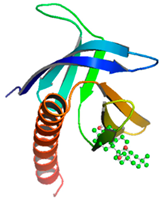 | 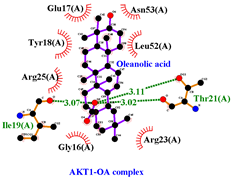 |
| CASP3 | 6BDV | −9.0 | 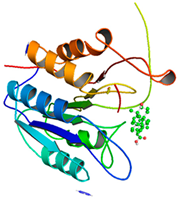 | 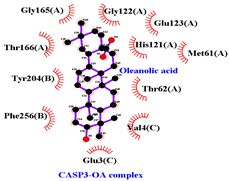 |
| LC3 | 1UGM | −7.0 | 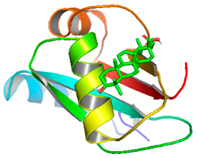 | 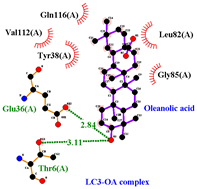 |
| SQSTM1 (p62) | 6JM4 | −7.2 | 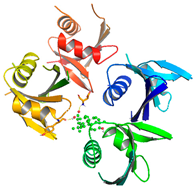 | 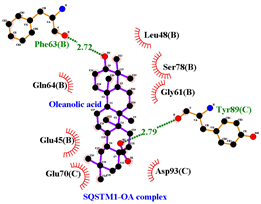 |
| NFE2L2 | 4IFL | −10.2 | 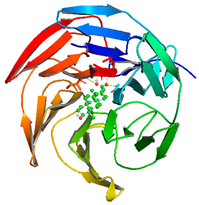 | 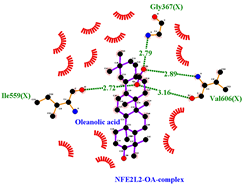 |
| PTEN | 1D5R | −9.6 | 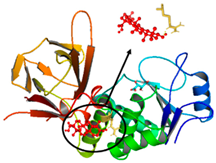 | 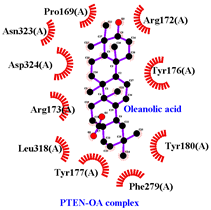 |
Disclaimer/Publisher’s Note: The statements, opinions and data contained in all publications are solely those of the individual author(s) and contributor(s) and not of MDPI and/or the editor(s). MDPI and/or the editor(s) disclaim responsibility for any injury to people or property resulting from any ideas, methods, instructions or products referred to in the content. |
© 2023 by the authors. Licensee MDPI, Basel, Switzerland. This article is an open access article distributed under the terms and conditions of the Creative Commons Attribution (CC BY) license (https://creativecommons.org/licenses/by/4.0/).
Share and Cite
Kim, Y.-S.; Lee, J.-C.; Lee, M.; Oh, H.-J.; An, W.G.; Sung, E.-S. Discovering Potential Anti-Oral Squamous Cell Carcinoma Mechanisms from Kochiae Fructus Using Network-Based Pharmacology Analysis and Experimental Validation. Life 2023, 13, 1300. https://doi.org/10.3390/life13061300
Kim Y-S, Lee J-C, Lee M, Oh H-J, An WG, Sung E-S. Discovering Potential Anti-Oral Squamous Cell Carcinoma Mechanisms from Kochiae Fructus Using Network-Based Pharmacology Analysis and Experimental Validation. Life. 2023; 13(6):1300. https://doi.org/10.3390/life13061300
Chicago/Turabian StyleKim, Youn-Sook, Jin-Choon Lee, Minhyung Lee, Hae-Jin Oh, Won G. An, and Eui-Suk Sung. 2023. "Discovering Potential Anti-Oral Squamous Cell Carcinoma Mechanisms from Kochiae Fructus Using Network-Based Pharmacology Analysis and Experimental Validation" Life 13, no. 6: 1300. https://doi.org/10.3390/life13061300
APA StyleKim, Y.-S., Lee, J.-C., Lee, M., Oh, H.-J., An, W. G., & Sung, E.-S. (2023). Discovering Potential Anti-Oral Squamous Cell Carcinoma Mechanisms from Kochiae Fructus Using Network-Based Pharmacology Analysis and Experimental Validation. Life, 13(6), 1300. https://doi.org/10.3390/life13061300






